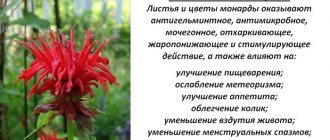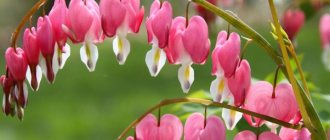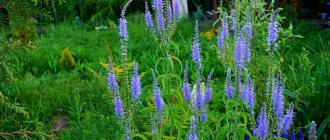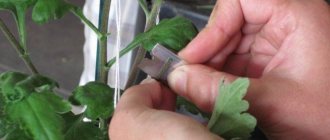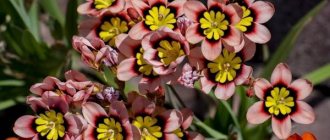Acanthus is a perennial herbaceous plant for open ground with amazingly beautiful, textured, carved, large, glossy leaves. Many gardeners and landscape designers use various types of acanthus to decorate their garden spaces, with beautiful foliage complemented by tall peaks of flowers. The plant looks attractive both alone and in group plantings, where the structure of their large pointed leaves is better visible. Many designers, architects, jewelers and artists draw inspiration from the exquisite shape of the leaf plate as a motif.
Plant care
Acanthus is very unpretentious and does not at all oblige the gardener to have any supernatural skills.
The main condition is good drainage. The plant tolerates even poor soil, but if it finds itself in cold and very wet soil in winter, it may die. Regular procedures: weeding, loosening and mulching will help maintain the decorative appearance of acanthus and give it the opportunity to well grow a lush green mass of leaves.
For the first few years, young acanthus shoots require mandatory shelter. The most common material for this is spruce spruce branches; you can also use non-woven fabric. The frozen roots of the plant do not produce enough shoots for flowering next year. However, this does not apply to adult specimens; they overwinter well and produce many flower stalks.
In the spring, in warm regions, acanthus is pruned, but only strictly after the formation of new ones, otherwise the entire bush can be ruined. Acanthus is an aggressor and can easily capture territory. This disgrace can be prevented by limiting the area where it grows. Old boards dug into the ground around the bush are suitable for this purpose.
Acanthus is very responsive to watering with warm water. In summer, it requires such water procedures at least twice a week. However, it is able to tolerate short periods of drought, provided that the soil around it is not completely stony from dryness.
Advice. From March to September, acanthus gladly accepts periodic feeding. They must be comprehensive and are carried out no more than once every two weeks.
Care
This crop does not cause any particular difficulties when grown in the Moscow region and other areas.
Even a short drought has a better effect on the plant than excessive irrigation. It is recommended to add a small amount of oxalic acid to the water. The shrub can grow in one place for a long time, and is rarely replanted.
This is usually required when the breeding site is chosen incorrectly. This error manifests itself in slow growth or in the fact that the enkianthus stops growing altogether. It must be replanted by transferring the soil into a new planting hole. The place for it is selected as carefully as possible and drainage must be taken care of.
Important: the shrub adapts to a new location within a few months
With the arrival of spring, fertilizer is used for rhododendrons. It must be mixed with compost. Any variety must be fed by placing the mixture in the top layer of soil. Autumn feeding is also needed. For this purpose, compost is used, which is laid directly on the mulch.
Already initially these bushes will look beautiful. Their inflorescences form only on old shoots. You should only use pruning shears to remove dried and outdated branches. Preparation for winter includes:
- mulching the adjacent circle;
- bending branches;
- creating a shelter from spruce branches and dry leaves;
- covering this thermal barrier with non-woven material (the entire cover is dismantled when the danger of frost disappears).
Features of Eucomis
Eucomis is a perennial herbaceous plant. The bulbs, reaching 80 mm in diameter, have an oval shape. There are also many glossy basal leaf plates, their shape is belt-shaped or ovoid. The height of the cylindrical peduncles is about 100 centimeters. Racemose inflorescences grow on them, which are similar in appearance to pineapple; they reach a length of about 0.3 m. The flowers are wheel-shaped, they are colored light green or white with a purple or brownish tint. The flowers consist of 6 lobes of lanceolate perianths, fused at the base, and another 6 fused stamens, which have swaying anthers. At the very top of the flower arrow above the flowers there is a bunch, which includes from 10 to 20 green bracts, it is thanks to them that this plant is similar to a pineapple. The fruit is a three-ribed capsule of a flat-round shape; inside there are ovoid or round seeds of a dark brown or black color.
Eucomis - an exotic bulbous plant
Watch this video on YouTube
Types and varieties
Acanthus has a fairly large species population; many varieties are cultivated in gardening, and some as indoor plants. Mostly heat-loving plant species are grown in greenhouses: obtuse and star anise.
Acanthus obtuse has other names - mollis or soft. The plant is not particularly tall and reaches 70 cm, although in its natural environment it can grow up to 150 cm. Large leaf blades are 30-60 cm long and 7-15 cm wide, forming a fairly voluminous rosette, painted dark green. The leaves have a beautiful shape, they are roughly cut with a shiny surface. Unlike other species, soft acanthus is characterized by the absence of spines.
The stem of the plant is straight, on it there is a long apical inflorescence-spike 20-40 cm in length. The corolla of the flower is about 5 cm in size and is white in color with purple veins. The bracts are a dark shade of lilac or pink, ovoid in shape. This species is very often used in landscape design due to the sculptural shape of the leaf blades and beautiful inflorescences. Acanthus soft has several popular varieties.
Tasmanian Angel grows up to 50-70 cm. The leaf blades are large in size (length 30-60 cm, width 5-15 cm), decorated with a border and white spots. "Tasmanian Angel" blooms with whitish buds with purple veins that form paniculate inflorescences. It is characterized by moderate growth and frost resistance; it should be covered for the winter, especially young bushes.
Anise leaf or mountain acanthus is quite often grown in greenhouses or as a potted plant. This evergreen perennial can grow up to 1.5-2 m. The leaves of the plant are glossy and smooth to the touch, dark green in color. The spiky cuts along the edges add to their beautiful appearance. The length of the plate is 20-30 cm, and the width is 6-10 cm.
Long inflorescences are formed from large white-purple buds growing singly in the axils of the bracts. For growth, the species prefers light and warm places, although in hot weather it needs light shading. In nature, the plant grows luxuriantly in the brackish water of mangroves on the Pacific islands and coastal areas of the Indian Ocean.
Acanthus acanthus is most often planted in garden plots as an ornamental plant. Under natural conditions, the flower can be found in Mediterranean countries, where it grows up to 80-150 cm. A characteristic feature of representatives of this species is the color of the petals: the upper ones are purple, and the lower ones are white.
The species has a garden form with strongly thorny leaves - acanthus acuminata. It is considered one of the largest representatives of the genus, the leaf blades grow up to 90 cm. They have a jagged shape with elongated spines on the edges of the leaves. The plant is also distinguished by such properties as winter hardiness. This variety blooms in August with numerous light mauve and white buds.
Balkan or Hungarian acanthus has the highest frost resistance of all species, but also blooms later than others. A characteristic feature of this species are leaf blades with deep cuts and lobes that taper closer to the base. They are matte green in color, grow up to 60 cm in length, and are distinguished by the absence of spines. The buds are painted white and pink, the bracts are purple.
Diascorid is a rare species that was discovered not very long ago in a mountainous area near Yerevan. The plant has solid leaf blades and elongated purple inflorescences.
2.Varieties:
2.1.Acanthus spinosus
A perennial ornamental plant with dark green, extremely attractive leaves. The leaf blades are deeply cut, openwork, and have small spines along the edges. The flowers are collected in inflorescences at the tops of the shoots.
↑ Up,
Height . From 30 to 200 cm.
Planting miscanthus seedlings in open ground
Planting of this crop is carried out in the spring from March to May, when the threat of return of frost has passed. Since this plant is heat-loving, you need to take into account that the seedling must get stronger and take root before the onset of the cold period. Otherwise, it will be very difficult for him to survive the winter.
Adults overwinter successfully if good shelter is provided for them.
Before planting, small holes are dug to fit the volume of the plant’s root system. The seedling is carefully placed in the hole, straightening its roots. After this, the hole is covered with earth, the area around it is compacted and watered.
This crop is characterized by aggressive root growth, so when planting, limiters are placed, which are used as pieces of slate. The limiters are dug into the ground to a depth of about 40 cm, and they must remain at least 10 cm above the soil surface.
There should be a distance of about 40 - 50 cm between miscanthus bushes.
After planting, the seedlings are regularly cared for, this will help them quickly get stronger and get used to the new place.
Propagation by root cuttings
Since the roots of the plant are very long, it is difficult to divide adult bushes without damaging the roots. Therefore, the best and easiest way to obtain young specimens is to use root cuttings.
Root cutting
To do this, in the spring, dig up the soil and cut off part of the root with visible leaf buds. You can divide its fragments so that each has at least 2-3 growth points. Plant the roots in moist compost mixed with 1 part sand, where they quickly take root.
The use of acanthus in garden design
This impressive perennial is used as a tapeworm and decorates semi-shaded areas of the garden in plantings with hostas or Rogers, and coniferous crops.
Young sapling of acanthus hungarian
In sunny areas, the pronounced texture of the leaves contrasts favorably with delicate, airy ornamental grasses, crocosmia, colorful heuchera, delphiniums, coreopsis, monarda, and yarrow.
flower composition
Acanthus plantings can become an excellent seasonal hedge, decorate paths, decorate low buildings and unsightly places on the site. The beauty of the plant is emphasized by decorative deciduous varieties of elderberry, scarlet, willow and turf.
Caring for spring flowers in the garden
Erantis does not need to be watered, since in spring the soil contains a lot of moisture, and in the summer months it goes into a dormant state. If, when planting these flowers, the necessary fertilizers were added to the planting holes, then you will no longer have to feed them. All that is required from the gardener is timely loosening of the rows, as well as weeding, which should be done even after the foliage dies.
For 5–6 years, you don’t have to worry about replanting spring flowers; during this time, lush, spectacular thickets will appear. However, then you must definitely dig up the plants, divide and plant them. It should be remembered that Erantis contains poison, so to plant such a flower, choose an area in a place that is difficult for pets and children to reach.
Diseases and pests
Since this plant contains poison, it is reliably protected from pests and rodents. If the soil contains a large amount of moisture for a long time, this can cause the development of gray mold on the root system. In order to prevent this, it is necessary to try to eliminate excess moisture from the soil, because the roots of this plant react extremely negatively to getting wet.
After flowering
When the spring flowering ends, its above-ground parts will gradually die off. Then the bush will begin a period of rest. This plant is highly frost-resistant, so it does not need to be covered for the winter.
Growing acanthus from seeds
Acanthus knight growing from seeds
Growing an acanthus plant will be successful if agricultural practices are followed. To obtain seeds, the top of the peduncle is broken off, leaving the lower part, which helps accelerate the ripening of the remaining fruits.
The seeds are sown in March, before sowing they are scarified (the shell is scraped off), then soaked in melt water, which is renewed every 7-8 hours . Before sowing, treat with a growth stimulator, aloe juice, hydrogen peroxide - whatever is on hand.
acanthus seeds
Holly seeds are germinated in damp sand, after which they are planted in bowls filled with breathable soil and covered with film, creating a greenhouse effect. The seed placement depth is small, from a centimeter to two. As soon as you see the shoots, the greenhouse is released from the shelter. Water moderately, making sure that the water does not stagnate. The required distance between plants is 3-5 cm in diameter. The best solution is to plant them in separate cups and then transfer them to a permanent place.
The cuttings are rooted in a container with damp sand at a temperature of 20-23°. As soon as you see that the top has begun to grow, this will serve as a signal that the roots have begun to grow. Wait a couple of weeks and you can plant the plant in the ground.
After the roots appear, the bushes are planted in a permanent place. Such seedlings will bloom in the third year. You can divide the bush with a shovel without digging, by inserting the shovel vertically between the fused roots. You should carefully remove the cuttings and transfer them to a previously prepared planting site. Plants are placed at a distance of 60-70 cm from each other.
Planting in open ground
Planting a crop in the open ground of a garden or vegetable garden is done only through seedlings. Young catharanthus are tender and react sharply to lower temperatures, so the seedlings are placed in the flowerbed in the last months of spring, when the temperature becomes stable and frosts are not observed.
When choosing a place for a future flower, it is worth considering that catharanthus is picky about the wind and prefers lighter areas. It is not recommended to plant seedlings in the shade: the plant will begin to stretch, stop blooming and lose its decorative effect. Young crops can be planted in hanging pots if they are ampelous or low varieties. The remaining varieties look good in group plantings, when the catharanthus is placed in the foreground. You can grow catharanthus in open ground directly from seeds, but it is recommended to use seedlings.
Humus is placed at the bottom of the planting holes, sprinkling the plant with loose substrate. A distance of 30 cm is maintained between each bush. If the seedlings were grown as a group in one container, then they are planted without dividing the bush, as is. The root system of the sprouts is easily intertwined; when dividing the young growth, the roots will be damaged, which will lead to the death of the plants.
For easy removal of the crop from the pot and convenient replanting, the container with the flower is watered in advance. The planted bushes are sprinkled with mulch and watered.
Scope of application
Rhododendron flower: views with photos, planting and care
The acanthus flower looks very impressive and beautiful against the backdrop of large trees and hedges, as well as in flower beds and in the interior. Large and majestic inflorescences and leaves will decorate your summer cottage and give it a bright accent. Acanthus looks very organic against the background of stones, giving a cozy atmosphere to the surrounding space. In addition, the plant looks natural and beautiful on the shore of a pond.
The bear's paw panicle is used as the basis for a bouquet for a man, and winter compositions look very attractive for a long time.
It is not safe for children to play near such a plant, as its thorns are quite prickly. Also, when working with it, you should protect your hands and exposed parts of the body. Acanthus thorns are not poisonous, but its injections can be very painful.
There is no doubt that acanthus is a unique plant that will serve as an excellent decoration for a personal plot. If you follow all the rules for growing, planting and caring for a plant, you can achieve excellent results and have an original flower on your property that will delight its owners with its beauty for many years.
https://tutknow.ru/garden_and_orchard/11357-akant-sovety-po-vyraschivaniyu-v-otkrytom-grunte-i-domashnih-usloviyah.html
https://dachnyedela.ru/tsvetnik/akant.html
https://nasotke.pro/tsvety/vyrashhivanie-rasteniya-akant




